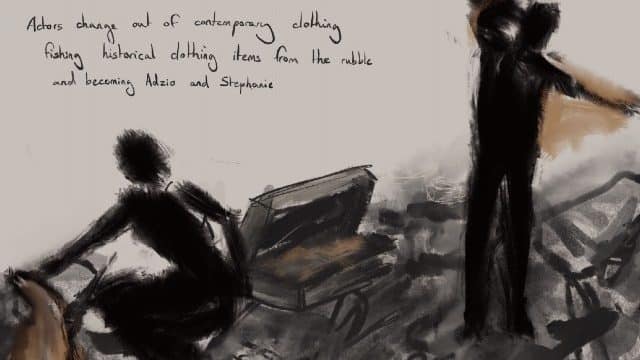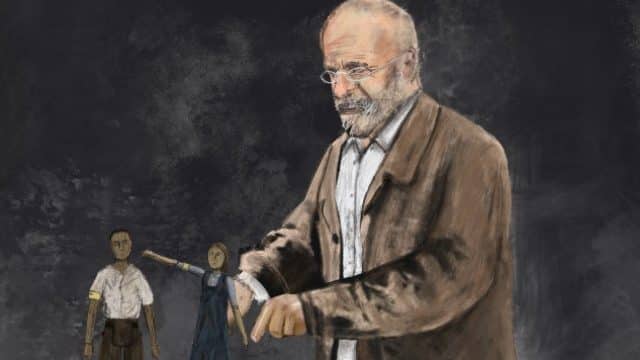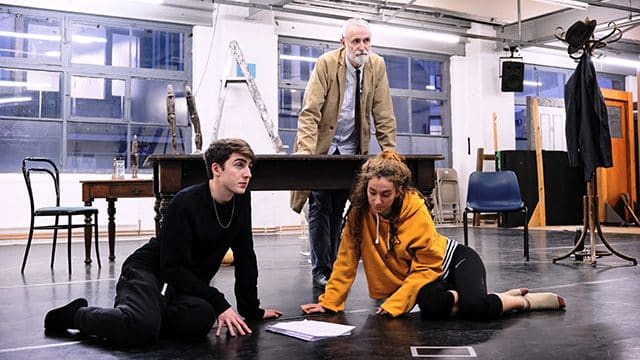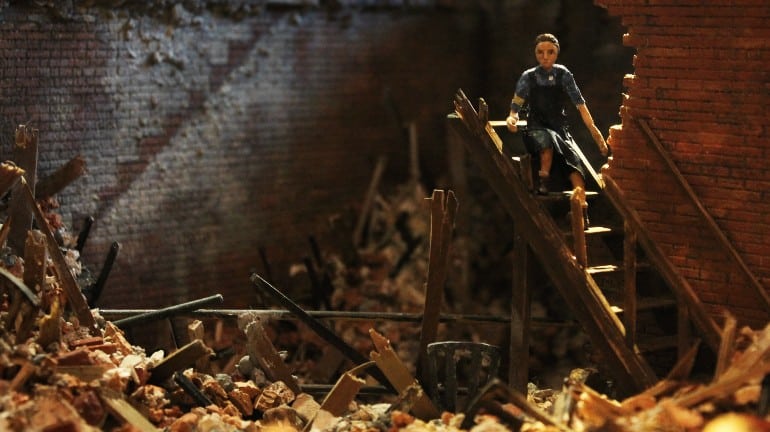Rose Revitt is a performance designer from Hebden Bridge and recent winner of the Linbury Prize — a prestigious award that now brings her innovative design for Dr Korczak’s Example to Leeds Playhouse.
The play by David Greig examines the final days of a war-torn Polish orphanage, where a shared sense of community and escapism is the single barrier against a wave of hatred.
We spoke to Rose to find out how she set about bringing a 1942 Warsaw ghetto to the new Bramall Rock Void space, whilst uncovering a little of what audiences might expect from this intimate, intense and emotional drama.
Hello Rose. So, what first made you want to become a production designer?
Good question. I think it’s because being a designer is all about telling stories and creating worlds — and they’re both really exciting things to do: to be able to help facilitate the telling of a story, in the special way that only the stage can, and other mediums don’t necessarily tune into.
Dr Korczak’s Example, for instance, is such a powerful story. So to be in the room with that story being told to you in such an intimate environment is an experience you don’t get in other mediums. I also like being part of the process and being able to collaborate with other people, which is really exciting.

And what led you to a career in theatre?
I trained at the Royal Exchange Theatre for a couple of years, in a wonderful Young Company, as a technician for a year. They also offered producing training, which I did for another year.
I realised how much I liked that working environment and felt very much embedded in the Royal Exchange during those two years. I loved my experiences there, but I was doing design in other capacities and I wanted to combine those two worlds together.
Was there a particular influence on your work at the time?
There were a number of people and I had wonderful support at the Royal Exchange. The person who was running the Young Company, Matt Hassall, was an incredible influence and he helped give us so much insight within the theatre.
We also had training from many practitioners who brought specialisms from different areas, so it was an amazingly eclectic view of the theatre world as a whole. Incredibly inspiring; even the things I learnt from areas you’d think were completely unrelated still feed into my work.
Tell us how you got involved in Dr Korczak’s Example.
I did an MA at the Royal Welsh College last year, and became involved through the Linbury Prize — a biannual award for recent theatre design graduates. You hear about the Linbury Prize quite a lot when you’re going through your training, so it felt like a natural step to try and apply for it.
There were a number of different rounds, which were interesting in their own way. We got to meet the design judges — incredible designers — who I was delighted to meet one-to-one, and we interviewed with four different companies who were taking part in the prize.
Leeds Playhouse was one of them, and I was completely delighted as I’m from West Yorkshire myself. It was incredibly exciting to be picked by what I consider to be one of my local theatres.
But it was quite a strange process, because I was designing a show whilst two other people were designing exactly the same production. So you’re putting your full commitment into a design and trying to make it the best thing possible, but you don’t know whether it’s going to happen — and that’s really unusual.

How long was the project?
All three of us spent a couple of months designing, individually having meetings with James Brining, the director, and developing our own individual concepts. We came at it, in some ways, in similar directions, and in other ways, very different directions.
We only saw each other’s designs when we set up our exhibitions at the National Theatre, and we could suddenly see what each person had been working on with their own approach to the story.
I was really delighted to find out I’d won the commission, which meant my design was going to be created. Often there’s quite a long period of time between an announcement and the show running, but with this particular show it was into action straight away.
I think it was the next day I received a call asking how quickly I could get to Leeds Playhouse to do a presentation and get the process underway…
It’s in a new space at the Playhouse — the Bramall Rock Void…
I found the space to be one of my biggest inspirations for the design.
I think the Bramall Rock Void has a wonderful character to it and a strong, intimate feeling. It has an inherent character in its walls and textures, so I’ve tied that into my design quite carefully, and the feeling of intimacy is very appropriate for this play.
The story starts by setting the scene of the Warsaw ghetto and the fact that there are too many people crammed inside a small area. So to have a space that feels vast in some ways — because it’s a very long space — but in other ways appears claustrophobic. That really helped the feeling of the design.
It’s been a very interesting space to work with. The Playhouse are still discovering just what can be achieved there.

The first show in the space, There Are No Beginnings, had a traverse stage. What’s the approach this time?
This time it’s end-on, but we’ve used the full length of the Bramall Rock Void. It’s an unusually-shaped room with an area beyond which has exposed rocks.
The audience are looking quite far down into the space, which provides a lot more depth than you’d normally get in a theatre space of this size, so it’s very focused.
There’s something about being part of that small audience, a charged group focusing on something, which is quite amazing.
It’s set in Poland, 1942. Did that demand a lot of research?
I did a lot of research, yes. I felt it was crucial, especially for a story like this. It became a process where I realised that the initial designs I’d generated weren’t engaging emotionally enough with the material; I needed to spend more time digging into the human aspect of it, as it’s such a devastating human story.
So I found the research process quite difficult, purely because of how horrifying many of the facts are. But it’s also incredible; I’ve spent a lot of time looking at photographs of the Warsaw ghetto, studying the lives of people, reading accounts and hearing interviews. That was really informative.
What was it like working with Director James Brining during that process?
It was wonderful collaborating with James. It was great to bounce around ideas and figure out our own approaches to the play. James knows this story very well — he’s directed it before — so knows what works and what doesn’t.
Meanwhile, I’ve come at it with a completely fresh palette, so we had some really interesting conversations to match those two sets of views together and figure out if we were on the same page, or discuss where we had different instincts.
Sometimes it’s more interesting to figure out what those different instincts are, to understand them, which leads to a better understanding of the story overall.

What do you think audiences will take away from the show?
I think they’ll take away a glimpse of the real human aspect of that time. It explores how you react to circumstances of severe adversity, and the different approaches you can take. It’ll really give the audience something to think about.
But also, it has some beautiful moments. A true mixture of light and dark, giving people a meaningful and memorable experience.
Dr Korczak’s Example is at Leeds Playhouse from 25th January to 15th February 2020. Book online at leedsplayhouse.org.uk or call the Box Office on 0113 213 7700.
Find out more about Rose Revitt’s work at roserevitt.com.


